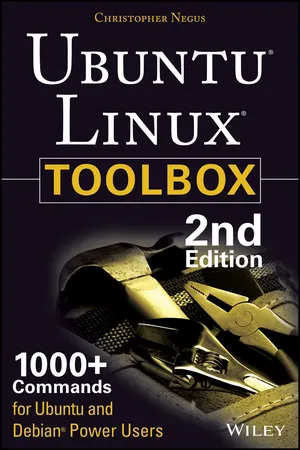
- English
- ePUB (mobile friendly)
- Available on iOS & Android
Ubuntu Linux Toolbox: 1000+ Commands for Power Users
About This Book
This updated bestseller from Linux guru Chris Negus is packed with an array of new and revised material
As a longstanding bestseller, Ubuntu Linux Toolbox has taught you how to get the most out Ubuntu, the world's most popular Linux distribution. With this anticipated new edition, Christopher Negus returns with a host of new and expanded coverage on tools for managing file systems, ways to connect to networks, techniques for securing Ubuntu systems, and a look at the latest Long Term Support (LTS) release of Ubuntu, all aimed at getting you up and running with Ubuntu Linux quickly.
- Covers installation, configuration, shell primer, the desktop, administrations, servers, and security
- Delves into coverage of popular applications for the web, productivity suites, and e-mail
- Highlights setting up a server (Apache, Samba, CUPS)
- Boasts a handy trim size so that you can take it with you on the go
Ubuntu Linux Toolbox, Second Edition prepares you with a host of updated tools for today's environment, as well as expanded coverage on everything you know to confidently start using Ubuntu today.
Frequently asked questions
Information
Chapter 1
Starting with Ubuntu Linux
- Introducing Ubuntu Linux
- Finding Ubuntu resources
- Learning quick and powerful commands
- Referencing useful utilities
- Working as Linux gurus do
- Commands—Tons of command line examples demonstrate clever and useful ways to navigate the often daunting command line.
- GUI tools—Quick tips for using graphical interface tools to administer and configure your Ubuntu system.
- Software repositories—Methods for downloading and installing the software, which is custom-made for your Ubuntu system.
- Online resources—Where to find useful and helpful information about Ubuntu, such as mailing lists that you can subscribe to, IRC channels, and other online resources.
- Local documentation—Tools for working with the man pages, the standard Linux and UNIX reference volumes, as well as specific documentation for the software you install.
Ubuntu, Debian, and Linux
- Xubuntu—An Xfce-based desktop system based on Ubuntu
- Kubuntu—A KDE-based desktop system based on Ubuntu
- Edubuntu—An Ubuntu derivative focused on schools
- Linux Mint—An easy-to-use desktop system with both Ubuntu and Debian roots
- Knoppix—A KDE desktop-oriented live CD based on Debian
- Kanotix—A Debian-based live CD
- Damn Small Linux—A tiny (50MB) live CD based on Knoppix
- Mepis—A desktop live CD based on Ubuntu and Debian
Understanding Ubuntu Releases
Ubuntu Compared to Other Linux Distributions
- Ubuntu Unity desktop—Taking its own direction, Ubuntu features its own Unity desktop, rather than use GNOME, KDE, or other common Linux desktop interfaces. Though based on GNOME, Unity seeks to simplify the user interface to make it more useful on smaller screens, such as those used on netbook computers.
- Mobile and entertainment devices—While Ubuntu has made some inroads into the enterprise computing arena, a more natural transition for Ubuntu from the desktop has been to specialty devices. The Canonical Group (www.canonical.com), which runs the Ubuntu project, announced an Ubuntu phone (www.ubuntu.com/devices/phone). There is also an Ubuntu TV project (www.ubuntu.com/devices/tv).
- Simplified installation—The complexity of booting and installing Ubuntu has been narrowed down to a handful of mouse clicks, making many of the install decisions automatic based on assumptions as to what the average user may need and want. A simpler instal...
Table of contents
- Cover
- Introduction
- Chapter 1: Starting with Ubuntu Linux
- Chapter 2: Installing Ubuntu and Adding Software
- Chapter 3: Using the Shell
- Chapter 4: Working with Files
- Chapter 5: Manipulating Text
- Chapter 6: Playing with Multimedia
- Chapter 7: Administering Filesystems
- Chapter 8: Backups and Removable Media
- Chapter 9: Checking and Managing Running Processes
- Chapter 10: Managing the System
- Chapter 11: Managing Network Connections
- Chapter 12: Accessing Network Resources
- Chapter 13: Doing Remote System Administration
- Chapter 14: Locking Down Security
- Chapter 15: Setting Up a Virtualization Host and Virtual Machines
- Appendix A: Using vi or Vim Editors
- Appendix B: Shell Special Characters and Variables
- Appendix C: Getting Information from /proc